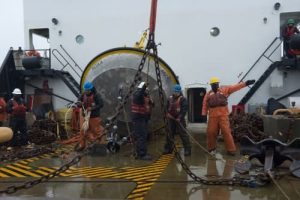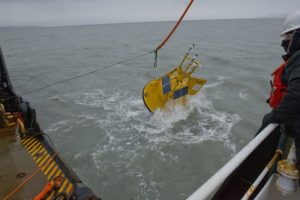
After days-long delays caused by rough sea conditions, the 225-foot USCG Buoy Tender Sycamore set out in 15-foot seas to take advantage of a fleeting weather window to install a new National Oceanic and Atmospheric Administration weather buoy early in the morning last week.
Using weather information from the NOAA weather office in Anchorage, the Coast Guard was informed via weather briefing predicting a potential weather window on December 10th, and so set out in the heavy seas to deploy the new buoy in Prince William Sound.
“Aboard with the Sycamore’s crew were two NOAA contractors and Coast Guard Chief Warrant Officer Daniel Delaet from the NOAA National Data Buoy Center in Bay St. Louis, Mississippi,” the Coast Guard reported.
“Planning and executing an NOAA weather buoy mission like this one in Alaska is unique,” said Chad Pool, current Coast Guard liaison at NDBC. “In this instance, the buoy, mooring, and equipment had to be shipped from Mississippi eight weeks in advance in order to arrive in Cordova and be placed on the Sycamore in time for their patrol. Delaet and our NOAA contracted technicians played a big role in getting it all up there.”

Weather is always a factor when the USCG undertakes a buoy tending mission. “When we get underway to launch or repair a buoy, it’s never a guarantee that we’ll be able to complete the mission on that trip, unless we get cooperation from Mother Nature,” said Chief Warrant Officer Jeffrey Ritter, 1st Lt. aboard the Sycamore. “But weather is what brings us on NOAA missions in the first place, whether we’re launching a buoy that will record it or fixing a buoy that was damaged by an 80-foot swell.”
NOAA weather buoy 46061 is a 3-meter buoy that records and transmits data that includes air and sea temperatures, as well as wind speeds, barometric pressure, and humidity. It also provides wave frequency, direction, and wave height.
“Like all NOAA weather buoys, this one is extremely important in providing a clear picture of weather and sea conditions to the maritime community,” said Cmdr. Michael Franklin, Captain of the Port, Prince William Sound. “This buoy is crucial to all classes of vessels entering Prince William Sound, including recreational vessels, commercial, charter, and sport fishing vessels, ferries, sightseeing vessels, cruise ships, tug and barge, and oil tankers to name a few.”
[content id=”79272″]
Data from Alaska’s weather buoys is also crucial in another aspect. Alaska, more than any other state is warming at increasing speed and the buoys contribute data to assist in understanding these changes taking place.








